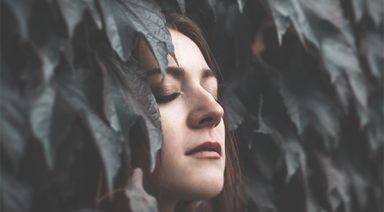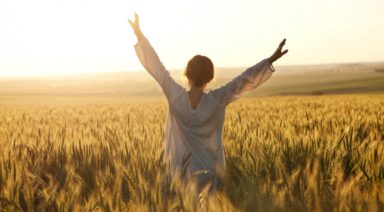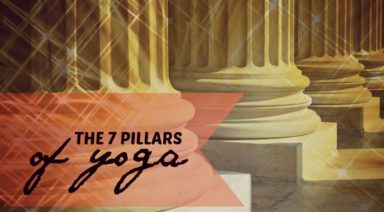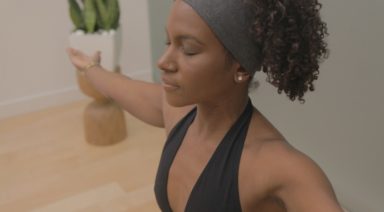Lalitha Invites Beauty and Play Through Sugarcane Pose

I’m sure at some point in your yoga journey you have unknowingly experienced Sugarcane Pose. Sugarcane pose’s English translation is rarely used. Instead, it is referred to as Ardha Chandra Chapasana, or just Chapasana. It is a standing backbend version of Half Moon Pose (Ardha Chandrasana). Ardha means ‘half,’ Chandra means ‘moon,’ Chap means ‘bow,’ and Asana means ‘pose’.
I’m half Filipina and I was lucky to have a father working for the U.S. government who was interested in working in Southeast Asia because he is Filipino, so I lived there until the age of 17. Whether we were in Taipei, Seoul, Manila or Jakarta, there would always be a street stand selling raw sugarcane.
As a result, I grew up gnawing on sugarcane husks, relishing in the flavor of the sugary sweet juice and the texture of the dense, fibrous cane. When I heard the name sugarcane pose and discovered that Lalitha was sometimes referred to as the Sugarcane Goddess, I felt very connected to both the pose and the goddess and wanted to know more.
Lalitha’s Depiction
One translation of Lalitha’s name is ‘she who plays.’ When we invite the essence of Lalitha into our lives, we are inviting spontaneity, playfulness, and joy into our lives. She is a form of Shakti Devi, the auspicious feminine energy relevant to the Universe or Source. She represents beauty, and her depiction conveys that.
Lalitha is usually seen seated on a lotus flower which guides us toward fulfilling our desires. She has long, black, gorgeous hair that smells like flowers, and a slight red tinge to her skin tone.
Her skin color is beautiful and represents the color of the first dawn or the hopefulness of new beginnings, and she is sometimes referred to as the Red Flower Goddess. She has four arms and a crescent moon adorns her forehead. In her hands, she holds a bow of sugarcane, five arrows made of flowers, a farming instrument for rounding up cattle (a goad), and a noose. The goad and noose represent our ability to develop an aversion (goad) to attachment (noose) and eventually find true joy.
Lalitha’s Sugarcane Bow and Arrows
Lalitha and her accouterments represent the energy that motivates our mind and how it interacts with all our senses. The sugarcane bow exemplifies the mind. Like sugarcane, sometimes we have to chew through the fibrous textures of our belief systems and thoughts to get to the sweetness. This is how we learn to experience spontaneity, joy, and happiness.
The five arrows are flowers. In esoteric terms, the arrows stand for the five elements of ether, air, fire, water, and earth. They also represent our various senses because the senses are consequences of the five elements. The sugarcane bow is used to discharge the arrows. Much like our mind has the ability to truly direct us towards fully experiencing sensations in the present moment. In this way, Lalitha is the power that enables us to feel and relish in sensations.
Experience Lalitha in Your Yoga Practice
If you’re like me and love using verbal callings (mantra), chant the following mantra out loud or silently to yourself as few or as many times as you feel compelled to. The mantra loosely translates to a simple way to call upon the mother goddess Lalitha.
MA AMBA LALITHA DEVI
NAMASTASYEY NAMO NAMAHA
I’ve personally found a combination of a long-held supine pose such as reclining butterfly, combined with a mudra (a hand gesture), and some breath work to be a quick and effective way to drop deeper into our internal world of consciousness and sensations. This is a potent way to relieve stress and feel more grounded within ourselves.
Lie on your back in reclining butterfly pose. Take a mudra called Pratyahara Mudra. This mudra means “withdrawal of the senses” and provides us with a way to filter what we experience from the outer world so we may focus on our inner world more keenly.
To form the mudra, hover your palms in front of your face, fingers pointing towards your nose jazz hands style:
-Lightly place your index fingers on the eyebrow (touch)
-Place your middle fingers on your eyelids (sight)
-Ring fingers rest on your nose, just above the nostril flares (smell)
-Pinky fingers lightly touch at the corners of your mouth (taste)
-Thumbs reach back to close the ears (hearing)
Once you have applied light pressure to close off all the senses, start taking deep full breaths. Hopefully, you will notice how all distractions from the outside take a back seat to what is actually happening in your body, mind, and heart.
The mudra, coupled with breathing is a way to give your brain a break. When the mudra is released, and the breathwork restores to normal, rhythmic breathing, we still maintain a deeper sense of self. This also translates into a deeper feeling of all the sensations we are experiencing in the present moment.
There are other ways to give our senses a break in our daily lives.
Monitor how much and what types of TV and social media you’re engaging in.
- Become discerning of loud noises and negative talk from certain people.
- Feel the soft fur of your pet or walk barefoot in the grass.
- Reevaluate your diet and opt to choose more whole foods.
- Fill your home with beautiful, even nostalgic scents.
On your yoga mat, after you’ve warmed up your hips, quads, shoulders, and hamstrings, you are ready to try Sugarcane Pose. It’s a balancing pose, so often I’ll use tree pose as a warm-up to help the body and mind prepare for balancing.
From triangle pose (or get more launched into it from warrior 2 or extended side angle), with the hips remaining open, balance on your front leg. First, take some time to feel Half Moon Pose with your top arm stretching to the sky and your top leg lifting towards parallel with the ground.
Once you feel stable and familiar with the pose, start to bend your top leg and practice reaching back to grab what you can. Remember, Lalitha is about not attaching to outcome and also relishing in the play of the pose!
In the Sugarcane Pose, your hand grabs your leg towards the ankle to create the sugarcane bow. Think of your side ribs and your heart as the arrows of the flowers. They blossom their petals with your breath and aim towards the front of your mat. Infuse your yoga pose with intentions that invoke sweetness and joy and non-attachment.
Remember to stay playful, and remember you are always beautiful!
Hanuman; The Ancient Monkey-Superman

The monkey god Hanuman, was given the birth name Anjaneya (powerful, fiery). He earned this name Hanuman when he was quite young. Playing in some green, grassy fields, Hanuman looked up and saw a big, orange, juicy sun and mistook it for a giant mango. Monkeys love mangoes!
He decided to leap into the sky and steal the mango for his afternoon snack. Indra Devi, the Sky God, saw what was happening on his home turf and became quite angry at Hanuman’s imposition, so he began throwing lightning bolts every which way. One of the lightning bolts hit Hanuman in the jaw (‘Hanu’ means jaw) and propelled him to the earth where he landed with a dramatic thump, killing him.
All the deities panicked in seeing his lifeless little body. They knew Hanuman’s dad would be furious, and he was. Vayu, the God of the Wind, saw his little son lying on the ground, lifeless. He went into grief and rage and started sucking the air out of the universe. Everything started to wither, shrivel up, and die; just like young Hanuman.
The deities came out from where they were hiding and begged Vayu to restore balance to the universe, to give it back its ability to live, breathe, and exist. Vayu claimed he would only do so if they brought his son back to life. Everyone readily agreed, as each deity walked over to Hanuman’s lifeless body and touched him. Each god who touched him infused a little life back into him, and unbeknownst to Hanuman, a little bit of their power.





































